Liferafts
Anyone who sails more than a few miles from a safe haven should consider a liferaft to be an essential piece of safety equipment.
Stowage
My personal preference is to have nothing stowed on deck if possible, 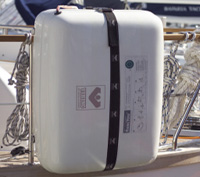 in practice unless you have a large vessel where the liferaft can be stowed on a purpose built cradle on the pushpit or in special deck lockers such as those found on Oyster yachts, the liferaft is nearly always stowed on chocks on the cabin roof.
in practice unless you have a large vessel where the liferaft can be stowed on a purpose built cradle on the pushpit or in special deck lockers such as those found on Oyster yachts, the liferaft is nearly always stowed on chocks on the cabin roof.
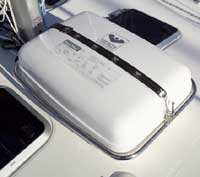
One obvious disadvantage of this stowage point, is that it nearly always obstructs the helmsman's view when handling the boat in the confined waters of a marina. A bigger problem may be that the straps used to attached the raft tend to work loose over time, I know of several occasions where liferafts have been swept overboard and inflated by large waves washing down the deck. For this reason the lashings must be checked for security and wear every day.
Hydro-static release
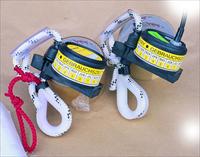
Ideally the liferaft should be able to deploy automatically if the vessel sinks before the liferaft can be deployed. This is one advantage of a deck stowage position. By using hydro-static release fittings, the liferaft will self-deploy if the yacht sinks very rapidly, such as when in a collision with a large vessel. These devices sever the securing cord once they reach a depth of 2-3m below the surface, the canister floats free and the sinking vessel pulls out the painter line which inflates the raft. The painter line should then rip free of the raft to prevent the raft being pulled under by the sinking yacht.
Care must be taken to ensure the hydro-static release mechanism is correctly installed to make sure the raft can deploy successfully.
If the liferaft is stowed in the bottom of a cockpit locker, it is likely to have other items stowed above it and be very difficult to deploy rapidly in an emergency.
If possible the liferaft must be deployed manually and the automatic releases should not be relied upon, especially on a sailing vessel, as there is a risk that the rigging of the vessel will foul the liferaft and drag it under.
It is a possibility that if the yacht Ouzo had been fitted with a deck mounted liferaft with hydrostatic releases, the crew may have survived the vessel's sinking.
Coastal liferafts
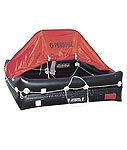
At the lower end of the price scale, liferafts are designed for short periods of use in moderate conditions where rescue services are likely to be deployed rapidly and the crew quickly recovered.
Liferafts of this type are typically constructed of a lighter materials, only have a single floor and cheaper ones may only have one inflatable tube. The equipment ready stored inside the liferaft will also be minimal and will only include the following: flares, bailer, sea anchor, repair kit, air pump, paddles, rescue quoit, anti-seasickness pills, drinking water, torch.
Ocean Liferafts
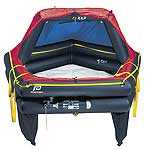
The more expensive liferafts are much stronger in construction, may have double floors that are inflatable to preserve heat, water catchment devices to catch rain water and extra safety features.
Rafts of this type are intended to keep the crew afloat and alive for long periods of time in open water and rough seas. The supplies inside the liferaft will still be fairly basic but more comprehensive than in cheaper rafts, they will include: 6 Leak Stoppers, Rescue Quoit, Bailer, Sponges, Repair Kit, Survival Manual, 1 Heliograph Mirror, Signal Tables, 3 Hand Flares, 1 SOLAS Rocket, Anti seasickness Pills, Sea Anchor & Swivel, Whistle, Seasickness Bags, Knife, 2 Paddles, Bellows, 2 Torches.
There may also be high calorie survival food, fishing equipment and a little water.

In extreme cases people have survived for months in rafts like this.
However, in most cases where shipwrecked crews have survived for a considerable time in a liferaft, they managed to take extra equipment, tools and water in a grab bag. Prior planning and preparation is essential, so that if you do have to take to your liferaft, there is an established plan in place with suitable supplies and equipment ready to grab as you go out of the hatch. There are many stories about the use of liferafts in real situations that are valuable reading for any skipper as part of their preparation for dealing with disasters.
Canister or valise?
A valise is a heavy duty bag that the liferaft is stored in, they are only appropriate when the raft is stored out of exposure to the elements in a dry locker. They are lighter to deploy than a canister, so if the raft is stored in a locker, this may be the only sort that can be lifted by the crew.
A canister is a heavy duty, sealed box in two parts. It should be weather tight, so it can be used for deck mounted liferafts. Canister rafts can be fairly heavy, one ten man raft I had on one boat could only be moved by the use of a block and tackle, so it would have been quite a handful to deploy in a hurry.
Whether the liferaft is stored in a valise or canister, the light straps that hold it closed should rip apart automatically when the raft is inflated.
Deployment
We always say that you should be stepping up in to your liferaft if you have to use it, meaning it is the absolute last resort. There have been many cases of a crew abandoning their yacht, where the yacht was later recovered still afloat.
- The raft should not be launched until everyone is ready to go, with everything that can be taken. If the raft is launched too early, it may rip off the boat and be lost before the crew can all board it.
- The heaviest person should board first to stabilise the raft and help others.
- It may be prudent to clip your harness to the painter whilst boarding.
- Once everyone is aboard, the painter should be cut with the knife by the hatch.
- The raft should be paddled clear of the sinking vessel (paddles are in the bags tied to the floor).
- The crew should all take sea sickness tablets as soon as possible.
- The sea anchor should be deployed.
- The hatch should be closed in bad weather.
- Jobs need to be shared out, lookout, bailing, housekeeping etc.
Remember you are not a survivor until you have been rescued!
The following books are essential reading for any serious sailors.
Liferaft stability
As soon as the raft is launched, the crew should board it to provide weight and keep it stable.
Modern liferafts have pockets on the bottom that deploy automatically when the raft is inflated, the idea is that they fill with seawater and add stability to the raft.
The other major factor in the stability of the raft is for the sea anchor to be deployed in rough weather. The sea anchor reduces the drift of the raft, but properly deployed, it also reduces the risk of the raft capsizing in heavy seas. Because of the risk of losing the sea anchor, it is worth having a spare on in your grab bag.
deployed in rough weather. The sea anchor reduces the drift of the raft, but properly deployed, it also reduces the risk of the raft capsizing in heavy seas. Because of the risk of losing the sea anchor, it is worth having a spare on in your grab bag.
If a liferaft capsizes, it can be turned over by one of the crew climbing on the the bottom of the inverted raft and keeping their feet by the gas cylinder and pulling on handles on the bottom, flip the raft back over, this wil be easiest if it is done in the downwind direction.
Servicing
The service period for liferafts varies from 1 to 3 years. Rafts must be kept in service as items such as flares and batteries will deteriorate and not work when needed but also there may be chafing inside the raft container and minor leaks may develop.
Some good liferaft service companies will allow you to watch your raft being serviced if you wish, this is one way of becoming familiar with the contents of your raft.
Sometimes it is possible to store extra items of equipment in the liferaft when it is packed, this may be items such as a
Emergency water makers,
Solar Stills
or survival book. There is not much room, but a few small items may be fitted in some cases.
Liferaft training
Viking Marine have a video of a liferaft deployment on their website. It is essential that at least some of the crew are familiar with the liferaft, its equipment and how to deploy it. The best way of gaining this experience is to attend a one day sea survival course.
Apart from being very enjoyable, a well run course makes people realise the seriousness and difficulty of having to make use of a liferaft for real. It will also encourage people to prepare for the worst, by prior preparation and hopefully to help avoid the situation where the survival equipment is the last thing that gets money spent on it.
Sailtrain.co.uk is free to use, but if you feel you would like to contribute to the running and development costs you can donate via Paypal:
Additional Resources:

